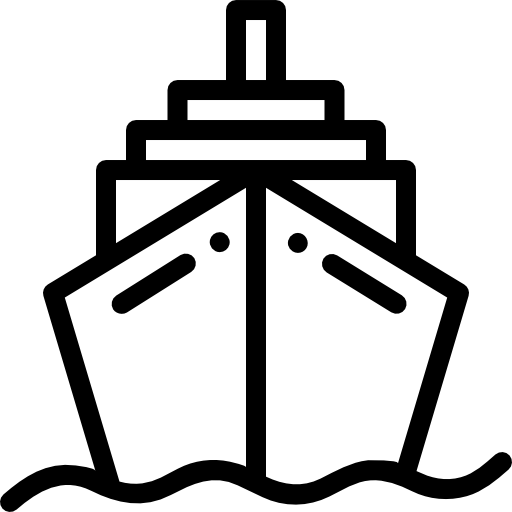SANT CARLES DE LA RÀPITA LIGHTHOUSE
HYDROGRAPHY REPORT. Year 1864.
"On 1st September 1864 this lighthouse will be lit located on the Senieta point, 8 cables South 30º west of the town of Sant Carles de la Ràpita, within the Alfaques Port. Its main characteristics are:
Fixed red light.
6th Order catadioptric device.
6 mile range.
Latitude 40º 36' 45" N
Longitude 6º 47' 00" E of San Fernando.
Elevation above sea level 9m.
Above land 6.8m
HISTORY
The tower is the natural stone colour of the stone from which it is built and the dome of the lamp is of a natural copper colour. It is of a cylindrical shape and occupies the centre of the keepers’ room, from which it protrudes 2.3m. This lighthouse in conjunction with the bell and rescue buoy which is found at 6.5 cables SW of Galacho point, mark out the entrance to the Alfaques port at night”. This text was the announcement to sailors of the beginning of service and main points about this light, successor to the fires that were previously lit at the tower of Sant Carles.
The best description and details are found in a piece written by the chief engineer of Tarragona Cecilio Cardenal in 1875:
"The lighthouse at Sant Carles de la Ràpita is of 6th order, fixed red light and is located at the entrance to Alfaques point, on the point named Senieta, at the foot of the hills at which point the dividing right arm of the Ebro branches out as it approaches the sea.
The building is found 40m from the edge of the sea and 2.2m above sea level.
The architecture is of a simple nature. On a plinth 0.50m high the masonry facades are raised, at a height of 2.90m along which run a cornice also masonry with a thickness of 0.30m, making the overall height of the building to its crown 3.70m. This is finished with a simple masonry parapet. On the main facade there is a door and two windows, one on each of the side facades and three on the rear.
It is made up, as is expected, of the dioptric area, and the second catadioptric hugging the first, whose radius is 0.30m, a vertical angle of 61,30' and the final 3, one of 144º 33', and respectively the upper and lower 5 and 3.
All of this is mounted on the bronze armature, made up of 4 meridians and 4 rheostats all supported on 4 feet ending in casters, that allow the device to be turned, this movement is guided by a vertical axle fixed in the centre to a column and that penetrates the base of the device. The bulbs used are spring controlled, of the usual shape. As well as being able to change the ignition the upper lid of the tank can be removed thereby allowing the entire lamp to be dismantled.
The total cost of the lighthouse is detailed below:
Cost of building works: 14,861.00 pesetas. Cost of device, light, lamp, etc.: 5,125.36 pesetas Furnishings: 2,732.50 pesetas Lightning rod: 102.80 pesetas Iron fence: 7,415.02 pesetas TOTAL: 30,326.68 pesetas
Missing from this summary is the cost of assembly of the device of which no record has been found in the offices of the province.
The Enginyer: Cecilio Cardenal
Initially refined olive oil was used as fuel. Later on the lamp was substituted for another Maris lamp of an odd series wick which was used thereafter with paraffin and petroleum. The first reported improvement came courtesy of a Royal Decree on 10th April 1918 in which a new light was fitted made up of groups of 3 and 2 white screens and an improvement in the lighting system.
For this improvement two carburettors each with a 4kg calcium carbonate capacity and permanent 17.5l ignition system were installed, designed to produce acetylene gas by way of a gas engine housed in a hut adjacent to the building. Also a set of 5 rotating screens were added to the lens, mounted on a mercury container powered by a perpetual motion clock movement and a new cylindrical light 1.8m in diameter, helicoidal mountings and a tower lined on the interior with mahogany, staircase with forged metal steps, Which was all purchased at the Spanish company "La Maquinista Valenciana".
The new look was premiered on the night of 29th August 1920 and the acetylene system on the following 2nd September. Electricity arrived in 1929 by way of 100 candle power filament bulb that kept the Maris lamp as a reserve until May of 1951, when it was substituted by an Aladino. The growth of the town and the increase in boat traffic, slowly but surely masked the light which became lost amongst the rest of the lights from the town. In 1956 Marine Command expressed the concerns of the lighthouse users who were now unable to distinguish the flashes.
As a solution the screens were substituted by a set of electric signal lights from the AGA Company, but this was still not enough. The final solution was to once again change the characteristics to a 4 and 1 red screens and an 11 mile range. This was made possible by a new lighting system that consisted of electric signal lights with a gas reserve from the AGA company, made up of shutter panels, a 500mm diameter dioptric drum lens, an incandescent 250w bulb, automatic changer, a photoelectric cell, a gas signal light with a 30l burner and VMS Diesel electric device, which began service on 23rd May 1975. The old system was donated to the Naval Museum of Barcelona, where it is still on display. The growth of the town and the increase in boat traffic, slowly but surely masked the light which became lost amongst the rest of the lights from the town. In 1956 Marine Command expressed the concerns of the lighthouse users who were now unable to distinguish the flashes. As a solution the screens were substituted by a set of electric signal lights from the AGA Company, but this was still not enough.
The final solution was to once again change the characteristics to a 4 and 1 red screens and an 11 mile range. This was made possible by a new lighting system that consisted of electric signal lights with a gas reserve from the AGA company, made up of shutter panels, a 500mm diameter dioptric drum lens, an incandescent 250w bulb, automatic changer, a photoelectric cell, a gas signal light with a 30l burner and VMS Diesel electric device, which began service on 23rd May 1975. The old system was donated to the Naval Museum of Barcelona, where it is still on display. The use of acetylene is being increasingly sidelined by the development of photoelectric systems. Slowly but surely the installations of the Delta lighthouses are being powered by solar energy. Since 1985 the San Carlos lighthouse is the only one remaining with this type of fuel, although only as a backup. Problems with handling and supply of gas led to its substitution and once again the installation is replaced.
On 2nd June 1995 a new system is installed consisting of a new electric signal light from the Balizamar Company equipped with 1000w, 220V halogen bulbs, fitted in an automatic changer capable of housing two of these. In this way the light is emphasised which, once again, had been masked by the continued urban growth.
To get to the lighthouse you must turn off the old national road to Vinarós some 800m from Sant Carles de la Ràpita and continue for approximately 150m. It is found at the edge of the beach and is integrated in a residential area which is totally developed and it stands out within the promenade that runs along the coast. The building is the original, rejuvenated and renovated on various occasions. The inside space has been substantially changed. It now houses an ample living space which is used by one of the head technicians of the province's maritime signal maintenance, an office and a hall. The exterior of the building has been complemented by two rectangular little houses. One that contains the electric backup equipment and is also used as a repair workshop and another which is used as a garage and for storage.
During the Civil War it was turned off by the Defence Committee of Tortosa from 17th March 1937 until the end of the following year.
Old images
https://www.porttarragona.cat/en/notes-de-premsa-rss/item/1758-sant-carles-de-la-rapita-lighthouse#sigProId1ffc4a6a60
Image Gallery
https://www.porttarragona.cat/en/notes-de-premsa-rss/item/1758-sant-carles-de-la-rapita-lighthouse#sigProIdb2a2e35e17























